day-to-day life in Asakusa, Ikegami and South Wales
Posted: 30/01/2012 Filed under: Books | Tags: BeeBooks, black and white photobooks, day-to-day life, KayLynn Deveney, Kishikawa Yōko, Koga Eriko, old age, photobooks from Japan, photobooks from the US 5 Comments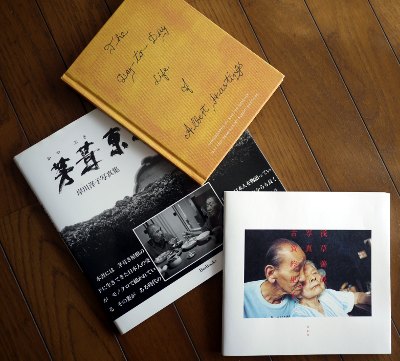
When Dan Abbe invited me to contribute my list of the top ten of 2011 to the 2011 street level eyecurious Japanese photobook extravaganza blowout, I was flattered but nonplussed. It was easy to come up with ten I liked, but hard to come up with more than three that thrilled (and of which no more than one was by any one photographer). Thinking that I might have forgotten this or that masterpiece and wanting to jog my memory, I took a quick look at the website of every photobook publisher I could think of. No, no masterpiece there that I’d forgotten — but there was word of a book I’d never seen but that looked good: Asakusa Zenzai (浅草善哉), by Koga Eriko (古賀絵里子).
On the first shopping day of the new year, I looked for and bought a copy.
Asakusa is an area of Tokyo that should be familiar to Tokyo residents and tourists and also to Kikai aficionados. It was once a major entertainment centre, but that was a long time ago; it’s now an old-fashioned shopping/entertainment centre (combined with a large and thriving temple). It’s also near some very poor areas. It’s the same zenzai as that in Oda Sakunosuke’s “Meoto Zenzai” (English translation in Stories of Osaka Life, highly recommended). So the title means something like “Hooray for Asakusa”.
The book is an intimate portrait, made over six years, of an elderly couple who had long run a small café in Asakusa. There’s explanatory text (in Japanese only) in the back of the book. A few facts from this: Hirata Hana was born in 1912; her future husband Nakamura Yoshirō was born in 1921. Hana worked in Araiya, a tempura restaurant, from 1936; this was turned into a parachute factory during the war but in 1945 she was back for its reopening as the western-style Fuji Kitchen. Yoshirō joined it in 1946. She started to run the Ayumi café in 1955; two years later, they married. The couple ran Ayumi until 1998, but after closing it continued to live there. Koga Eriko happened to meet the couple in 2003, and photographed the couple until shortly before Yoshirō’s death in 2008 (Hana died in 2010).
None of the photographs is captioned, but most don’t need captions (though some would be welcome). The couple spend much of their waking hours in what used to be their shop, using its counter for their meals, napping next to it, and so on. We see them watching television, smoking, even in bed. We never see either of them outside, and the outside world only rarely intrudes. It’s a very old-fashioned life, with deliveries of ice instead of a refrigerator, and a methodical one, with each day’s weather noted in one month’s page of a calendar. A few of the couple’s photographs from decades earlier appear among the newer ones. Toward the end we see the café deserted and the building boarded up, but we don’t see it pulled down.
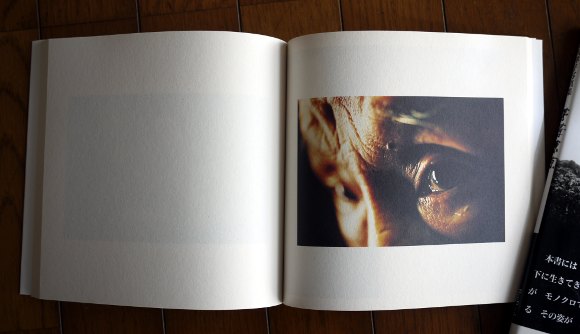
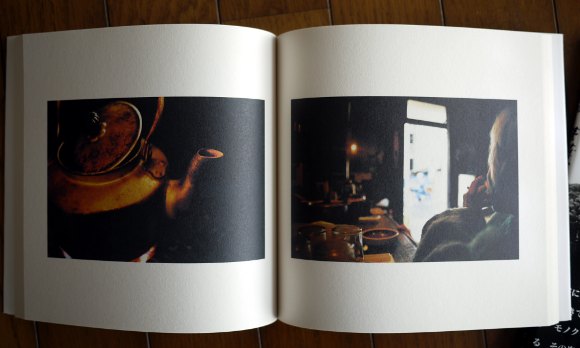
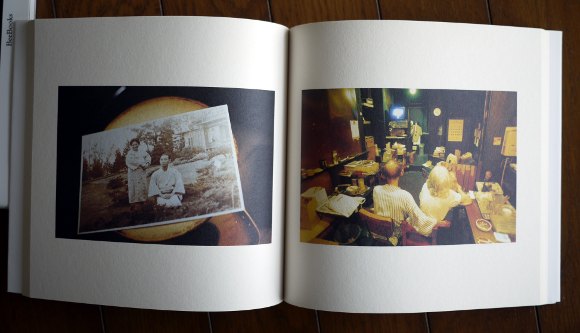
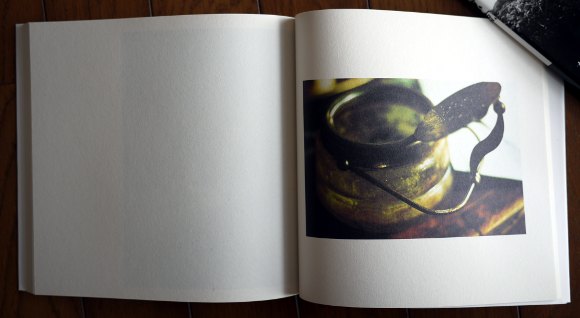
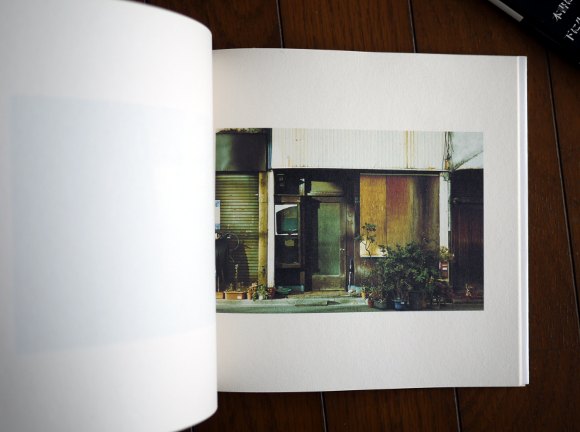
Photographs and sequencing are excellent. The book is compact: 20×19 cm. It’s printed on paper that looks more normal for a throwaway novel than a photobook, and the printing is of course no better than such paper allows. The price is modest, and maybe the size and paper were chosen in order that the package might appeal more to people who are somehow intimidated by the kind of production that normally appeals to me. If this helps this book become as popular as Ume-me or Mirai-chan, then so much the better.
And remember, these photographs (as well as photographs of Kōya-san) are at the Emon Gallery until 20 February. (Details.)
Some of the photographs appeared earlier in issues 26, 28 and 29 of Kaze no Tabibito (風の旅人), one of the very few recent Japanese magazines that have been worth looking at. Not being devoted to conspicuous consumption, self-beautification, celeb gossip, or some particular obsession, it struggled and last year eventually died. Here’s the set of 44 issues.
Asakusa Zenzai brought to mind another photobook, from 1998. It’s titled Kayabuki Tōkyō: Furusato no zanzō (茅葺東京 ふるさとの残像), i.e. “Thatched Tokyo: The lingering picture of an old village”. In 1982 the photographer Kishikawa Yōko (岸川洋子) was introduced to an elderly couple in Ikegami (close to Ikegami Honmon-ji) in what during the twentieth century had turned from farmland into an inner suburb of Tokyo. The pair had long been farming there, gradually selling off their land and having houses and blocks of flats built ever closer, but were still living in a handsome Meiji-period house with a thatched roof, and still growing their own vegetables. Photography started quickly.
In the book, we see the couple inside, of course, but also out in the garden, and about — for example, we see the wife (Tetsu) at the hairdresser’s,
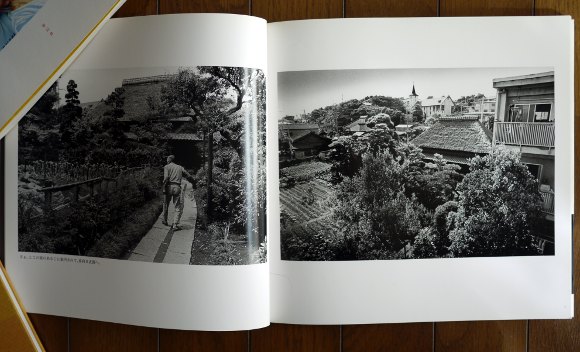
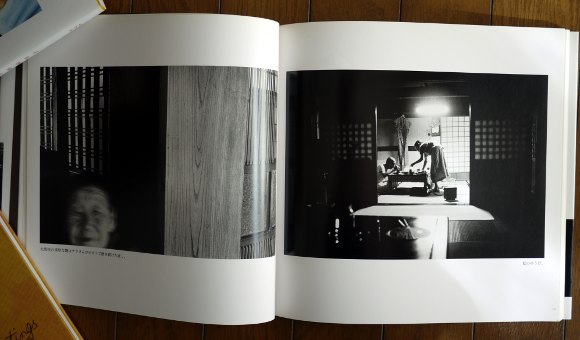
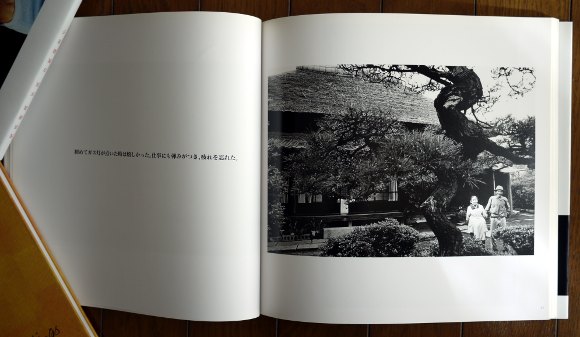
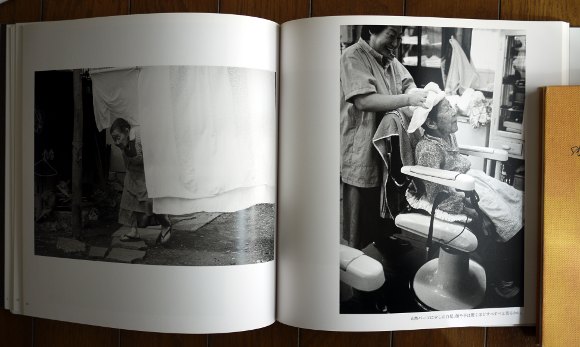
Tetsu died in 1989 at 90; her widower (昌一, so most likely Shōichi, but perhaps Masakazu or some other reading) died in 1993 at 94. There’s a photograph of him after her death. After both had died, the building was pulled down.
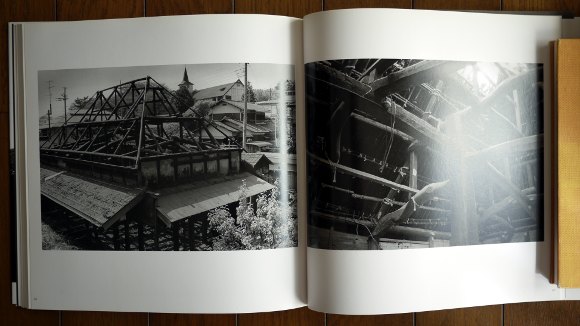
The book is bigger than Asakusa Zenzai: 25×24 cm. And like all BeeBooks I’ve seen, the printing is excellent. BeeBooks is the vanity publishing arm of Mitsumura, a major printing company. There have been over 700 titles, and many are humdrum indeed. (Piles of them appear at “Book Off”.) But the BeeBooks list includes some gems, and this is one. (The ploddingly titled 鳥山晃写真集 = Photographs by Akira Toriyama is another.)
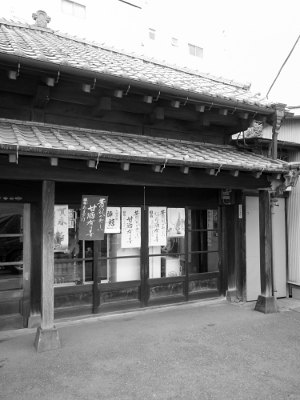 We’re not told when during the Meiji period (1868–1912) the house was built, but even houses put up as recently as 1912 are rare in Tokyo. Indeed they are rare anywhere in Japan, but in Tokyo the earthquake and fire of 1923 and the US firebombing of February–May 1945, plus the price of land and pressures to “develop”, have all reinforced other trends. But on one of the main routes between Ikegami station and Ikegami Honmon-ji still stands a nineteenth-century liquor store / off-licence / bottle shop. (If you’re in the area, support it by buying something. I generally buy a couple of cans of Yebisu on my way home, but the stock isn’t limited to booze.)
We’re not told when during the Meiji period (1868–1912) the house was built, but even houses put up as recently as 1912 are rare in Tokyo. Indeed they are rare anywhere in Japan, but in Tokyo the earthquake and fire of 1923 and the US firebombing of February–May 1945, plus the price of land and pressures to “develop”, have all reinforced other trends. But on one of the main routes between Ikegami station and Ikegami Honmon-ji still stands a nineteenth-century liquor store / off-licence / bottle shop. (If you’re in the area, support it by buying something. I generally buy a couple of cans of Yebisu on my way home, but the stock isn’t limited to booze.)
The potted bio in the back of this book doesn’t mention either an earlier book or any profession, so I’d guess that Kishikawa was an amateur and that this was her first book. I don’t know whether she has exhibited or published another book since. (There is a later book titled 長崎・東京二人三脚夫婦旅 that’s cowritten by a 岸川洋子 — same name, but not the same person.)
Lastly for today, The Day-to-Day Life of Albert Hastings, by KayLynn Deveney. Deveney, previously a photographer for the Albuquerque Tribune, was a graduate student of photography at Newport when in 2001 she got to know Albert Hastings, who was living nearby, in an unnamed Welsh town (presumably Newport or close by). Widowed for over forty years (his wife appears below), he was already well into his eighties when they met. A very orderly man, he let Deveney photograph the infraordinary routines of his daily life, outside his house as well as in.
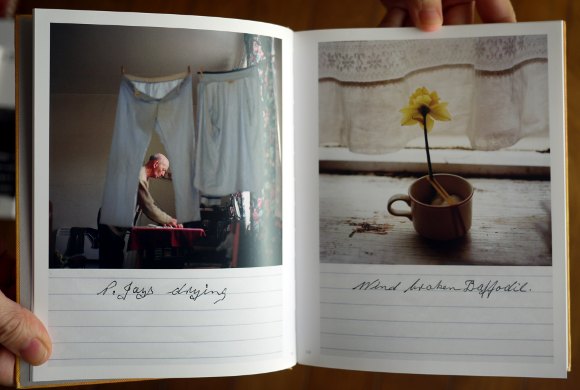
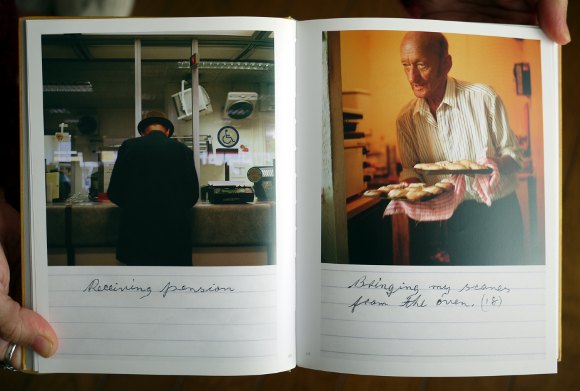
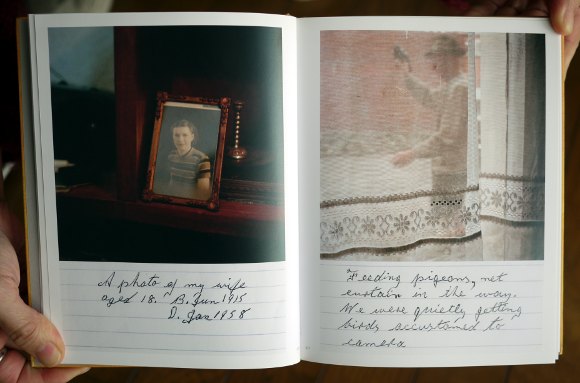
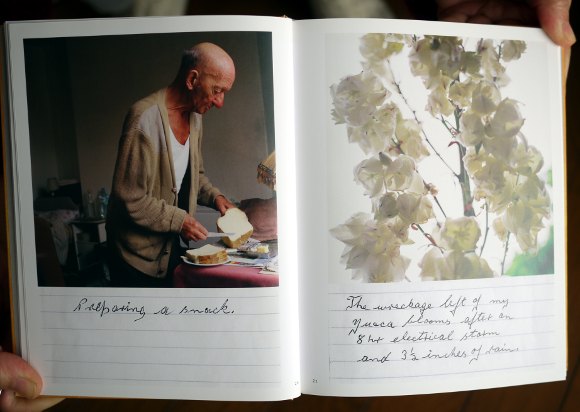
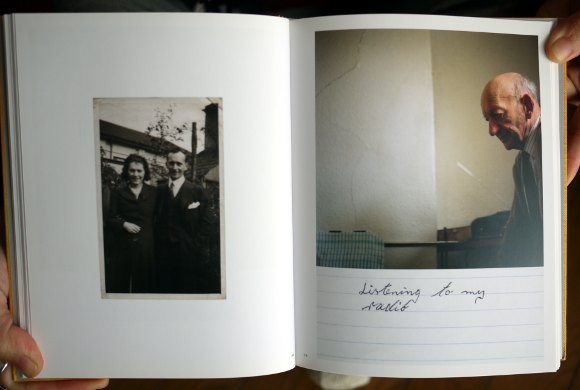
It’s another compact book: 21×16 cm. The photography and the sequencing are first class. But there’s an extra layer of interest here, as Albert took up an invitation to title the photographs, and did so simply but with some wit.
My copy of this book was remaindered (there’s a thick black line at the bottom); I’ve no idea why. Anyway, it was cheap. But that was years ago — there are now a great number of reviews of the book and most if not all are favourable. Prices of used copies are now far above the recommended retail price when new; the publisher should reprint this.
Oddly, Deveney’s website says nothing about her photography after this project; but in this 2009 interview she talks of photographing 1950s/60s “Cinderella houses” in Albuquerque and elsewhere in the US.
If you’re outside Japan and want to buy one of the Japanese books, see my general advice.
The photograph of the liquor store is mine; copyright of the other images above belongs to Koga Eriko, Kishikawa Yōko, KayLynn Deveney and the estate of Albert Hastings, not to me.
A tip of the hat to Colin Pantall for pointing out an oddity in what I wrote above (since corrected).
I think the Day-to-Day Life of Albert Hasting is my favourite photo book of all time (so far). I saw Asakusa Zenzai in a book shop a couple of days away and it immediately reminded me of Kay Lynn Deveny’s book.
Both well worth the money.
I hope you bought “Asakusa Zenzai”! If you did, bring it to the Emon gallery and have it signed there. If you didn’t, go to the Emon gallery and buy one there and have it signed there. Be sure to round out your collection with “Kayabuki Tōkyō”: copies are easy to find now, but considering the number of people avidly following this blog, copies will be . . . uh, just as easy to find next month and next year as they are now.
As for me, I hope to be able to see Elin Høyland’s “The Brothers” (on various “best of 2011” lists) some time soon.
I’ll have a look for Kayabuki Tokyo but I’ve spent my photo book budget for this month so I’ll wait. Oh, hang on… It’s February today 🙂
I’m in Nagoya so the Emon Gallery would be a bit of a trek. I wish Nagoya had more galleries… sigh.
The Day to Day Life is great. Devenney was doing a PHD I think when she made the book. I was starting an MA at Newport and she gave a talk about making the book on our first day – which was very inspiring. Thanks for the list. And glad you like Billy Monk – not so much a book as a collection of stories.
Thanks for the correction, Colin. I’ve done a bit of rewriting accordingly. (Deveney got her MA in 2001 and met Hastings in 2001, I don’t know which came first. Not that it really matters, of course.)
I’d never heard of “The Day-to-Day Life” when I happened to notice a pile of copies, priced very low, in a rather swanky Tokyo photobookshop that (like most photobookshops) goes in much more for the elegantly soporific. The low price and odd cover design combined to persuade me to take a look inside. I immediately bought one copy for myself and one for a friend. The book was only a year old at the time and I was amazed that it had already been remaindered.
Yes: So far I only know Billy Monk via JPEGs, but I’m keen to see the book.